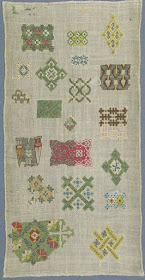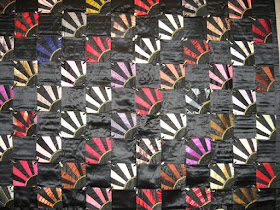Miniature apron with instructions as how to make one
I've been doing a little research for my sister who volunteers at the town historical society. They have an unidentified item, a needlework sampler booklet that is labeled "Chicago Training School for Sewing, class of 1901."
They are no where near Chicago and we can't figure out why it is even in the collections---except that small museums used to collect anything old.
I figure it is a school girl project made during a sewing class. I couldn't find the Chicago Training School for Sewing but I did find reference to the Chicago Industrial School for Girls, which had over 500 students (residents?) in 1915 ages 3-18. They were taught sewing, embroidery and other skills deemed useful for girls who had fallen into the juvenile justice system of the era. The booklet probably came out of that school or something similar.
UPDATE: See the comments. SusieQ found a reference to the Methodist institution Chicago Training School for Home & Foreign Missions, founded by Lucy Rider Meyer and Josiah Meyer in 1885. I bet this is it because in the back of the booklet are clippings about foreign missions.
UPDATE: See the comments. SusieQ found a reference to the Methodist institution Chicago Training School for Home & Foreign Missions, founded by Lucy Rider Meyer and Josiah Meyer in 1885. I bet this is it because in the back of the booklet are clippings about foreign missions.
They decided to de-accession the sampler book to another nonprofit, so I am
bringing it to AQSG's seminar this week to sell in the silent auction.
Money to AQSG.
Typical American schoolgirl sampler 1790 by an 11-year-old
from M. Finkel & Daughter who specialize in samplers.
There is a long history of stitching a pictorial sampler of needlework as a teaching tool. We are most familiar with "samplers," a single piece of stitchery, often done by young students.
Collection of the Victoria & Albert Museum
But there is also a long tradition of samplers of
sewing stitches---no pictures. This one 1600-1650.
Collection of the Victoria & Albert Museum
1785
Eliza Broadhead learned useful darning stitches at the Ackworth School
What we are discussing here, though, is a booklet rather than a single piece.
Darning samples in a book
Here's an early 20th century version, a handmade book.
The student has clipped the typed instructions for the stitches
and glued them into her booklet.
A gathered sleeve,
examples of plain sewing
An old-fashioned seam butting two selvage edges together.
In the Chicago example she handwrote the instructions.
Crochet motifs stitched to a fabric page
and bound together with a hand stitch.
This one looks to have been printed just for the purpose
of inserting samples.
Notice the tiny bootie knit for a china doll
The Victoria & Albert has a great example made by Ellen Mahon
at the Boyle School in Ireland, 1852-1854
The miniature clothing!
Lace samples from the Fitzwilliam Museum in Cambridge, England
Another from their collection, dated 1835
Ireland 1833
It looks like samples have been glued into an instruction book., probably
printed just for that purpose.
Some of these might be commercial---samples of pattern
one could order from a workshop, perhaps.
My favorites are the handmade cloth books, which
seem to have inspired artist Mandy Patullo at Thread & Thrift
Here are instructions on making one as a teaching tool today.





































































